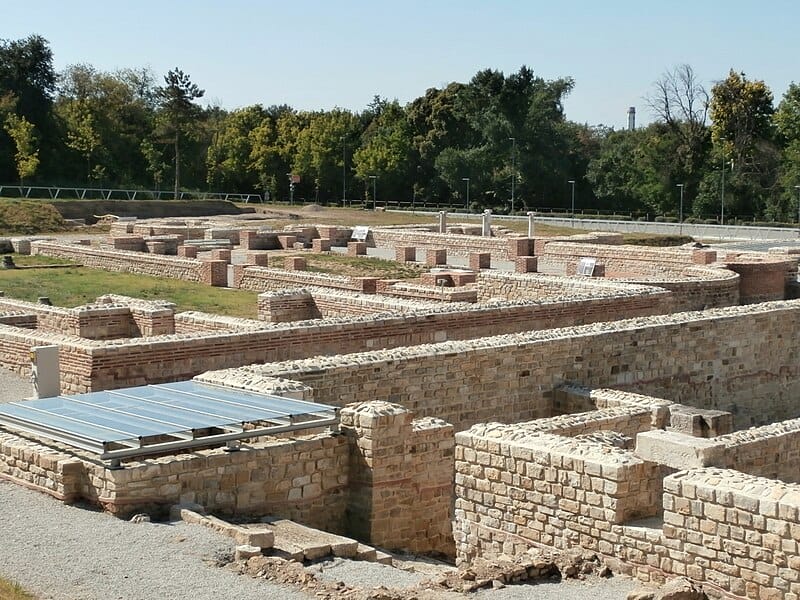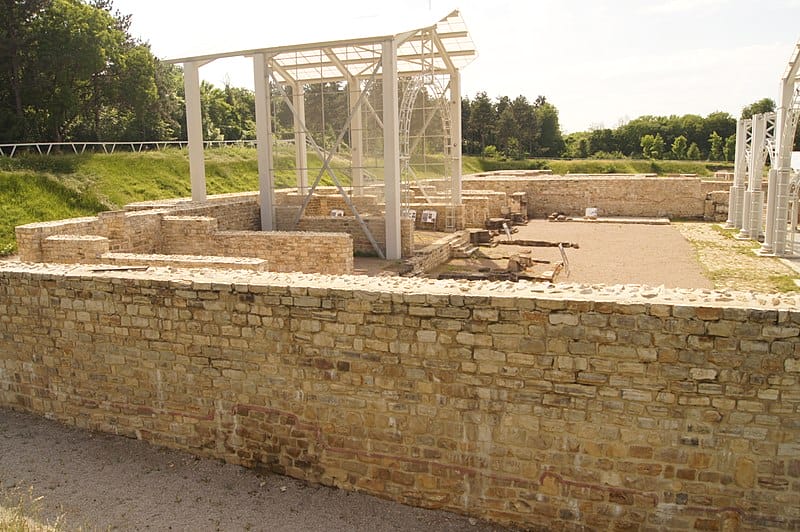In the domain of archaeology, every discovery holds the promise of unveiling a piece of history, offering a window into the lives of our ancestors. Such is the case with the recent revelation of an ancient Roman ‘fridge’ at the Novae Camp in Northern Bulgaria, where archaeologists unearthed a remarkable structure reminiscent of an ancient Roman ‘fridge.’ This remarkable find, containing drinking vessels and animal bones, has sparked considerable intrigue and shed new light on the culinary practices of the ancient Romans. In this article, we embark on a journey to explore the significance of this discovery, delving into its historical context, deciphering its contents, and unraveling its implications for our understanding of ancient Roman life.

Learning more about Ancient Roman Life
The Novae Camp, located in present-day northern Bulgaria, stands as a testament to the military might and strategic importance of the Roman Empire. Originally established in the 1st century AD as a military outpost along the Danube River, the camp served as a vital stronghold guarding the empire’s northern borders. Over the centuries, it evolved into a bustling military settlement, housing troops and serving as a hub of commerce and cultural exchange.
It is essential to give more context to this site within the broader history of the Roman Empire in order to understand the significance of the ‘fridge’ discovery at the Novae Camp. Namely, during the Roman period, military camps like Novae played a crucial role in maintaining control over vast territories and safeguarding imperial interests. These camps were not merely military fortifications but also vibrant centers of activity where soldiers and civilians coexisted, shaping the cultural and social landscape of the region.
The recent discovery of a unique structure within the confines of the Novae Camp has captured the attention of archaeologists and historians worldwide. Often likened to an ancient Roman ‘fridge,’ this structure offers valuable insights into how the inhabitants of the camp stored and preserved their food and beverages.
Deciphering the Contents: Drinking Vessels and Animal Bones
Central to the significance of the Novae Camp ‘fridge’ are the artifacts found within its confines. Among the most notable discoveries are a plethora of drinking vessels, ranging from intricately decorated amphorae to simple pottery cups. These vessels were likely used to store and serve various beverages, including wine, water, and perhaps even more exotic concoctions.
In addition to the drinking vessels, the ‘fridge’ contained a substantial quantity of animal bones, providing clues about the dietary habits of the camp’s inhabitants. Analysis of these bones can reveal the types of animals consumed, as well as the methods of food preparation employed by the ancient Romans. From the remains of domesticated livestock to wild game, each bone tells a story of sustenance and survival in the harsh environment of the Danube frontier.

The discovery of the Novae Camp ‘fridge’ offers a compelling glimpse into the culinary practices of ancient Rome. It highlights the importance of food preservation in a society where access to fresh produce could be limited, especially in remote military outposts like Novae. By storing perishable goods in specialized structures, such as the one found at the camp, the ancient Romans were able to ensure a stable food supply, essential for sustaining both military personnel and civilian populations.
The presence of drinking vessels suggests that the Novae Camp ‘fridge’ served not only as a storage facility but also as a communal space where residents gathered to socialize and partake in shared meals and libations. In this sense, food and drink served not only as sustenance but also as a means of fostering social cohesion and camaraderie among the diverse inhabitants of the camp.
One of the most intriguing aspects of the Novae Camp ‘fridge’ is its practicality and ingenuity because it is constructed using materials they have found within the area of the camp, such as stone and mortar. The structure was designed to maintain a relatively stable temperature, ideal for preserving perishable goods. Its strategic location within the camp, away from direct sunlight and insulated from external elements, further enhanced its efficacy as a storage facility.
The Socio-Cultural Implications: Dietary Habits and Social Dynamics
Beyond its utilitarian function, the Novae Camp ‘fridge’ offers valuable insights into the socio-cultural dynamics of ancient Roman society. The variety of drinking vessels found within the structure suggests a degree of social stratification, with different vessels perhaps reserved for individuals of varying status or rank. Similarly, the assortment of animal bones speaks to the diverse dietary preferences and culinary traditions of the camp’s inhabitants, reflecting a complex tapestry of cultural exchange and adaptation.
As archaeologists continue to study the artifacts unearthed at the Novae Camp, new discoveries and insights are likely to emerge. Further analysis of the drinking vessels and animal bones, coupled with advances in scientific techniques, holds the promise of deepening our understanding of ancient Roman life and society. The discovery of the ‘fridge’ at Novae underscores the importance of ongoing archaeological research in preserving and interpreting our shared cultural heritage.

Reflecting on Ancient Roman Life through the Novae Camp Discovery
The discovery of an ancient Roman ‘fridge’ at Novae Camp in Northern Bulgaria marks a significant milestone in our ongoing quest to unravel the mysteries of the past. Through meticulous excavation and analysis, archaeologists have unearthed a treasure trove of artifacts that offer invaluable insights into the culinary practices, social dynamics, and ingenuity of ancient Roman society. The more we learn about this discovery, the deeper appreciation we gain for the complexities of life on the Danube frontier and the enduring legacy of the Roman Empire.
At its essence, the Novae Camp ‘fridge’ represents more than just a utilitarian storage facility, as it is a testament to the resourcefulness and adaptability of the ancient Romans. In a region characterized by harsh climatic conditions and logistical challenges, the ability to preserve food and beverages was essential for survival. By constructing specialized structures like the one found at Novae Camp, the inhabitants demonstrated their mastery of food preservation techniques and their commitment to ensuring a stable food supply for both military personnel and civilian residents.

The contents of the Novae Camp ‘fridge’ provide rich fodder for exploration and interpretation, offering tantalizing glimpses into the daily lives and dietary habits of its inhabitants. The abundance of drinking vessels speaks to the importance of communal dining and socializing in ancient Roman society. Whether gathered around a shared table in the mess hall or enjoying a leisurely banquet in the comfort of their homes, the residents of Novae Camp found solace and camaraderie in the act of breaking bread together.
Similarly, the assortment of animal bones found within the ‘fridge’ offers valuable clues about ancient Roman culinary practices and dietary preferences. From the remains of domesticated livestock to the bones of wild game, each artifact tells a story of sustenance and survival in a frontier environment where access to fresh food was often scarce. Through careful analysis, archaeologists can reconstruct the culinary landscape of Novae Camp, shedding light on the types of meals consumed, the methods of food preparation employed, and the social dynamics that shaped communal dining experiences.
Conclusion
Beyond its practical implications, the Novae Camp ‘fridge’ holds broader significance for our understanding of ancient Roman society and its enduring legacy. By uncovering the material remnants of daily life at Novae Camp, we gain a more nuanced appreciation for the complexities of Roman military culture, the interplay between military and civilian populations, and the ways in which food and drink served as conduits for social interaction and cohesion.
Looking ahead, the discovery of the ‘fridge’ at Novae Camp opens new avenues for research and exploration, inviting scholars to delve deeper into the mysteries of the past. Through interdisciplinary collaboration and innovative methodologies, we can continue to unravel the secrets of ancient Rome and illuminate the lives of those who called Novae Camp home. As we stand on the threshold of discovery, let us remember that each artifact unearthed is not just a relic of the past but a window into the human experience, connecting us to our shared heritage and inspiring us to explore the untold stories of those who came before us.
People Also Ask:
Why is Novae Camp important?
Novae was an extremely important part of the defense line of the Roman Empire because the legion accommodated here was guarding the conquered territories in Thrace and Macedonia from the raids of tribes coming from the East.
Was the Novae Camp an eastern border of the Roman Empire?
Novae was initially one of the few great Roman legionary fortresses along the empire’s border, forming part of the defenses along the Danube in northern Bulgaria. The settlement later expanded into a town in the Roman province of Moesia Inferior, later Moesia Secunda.
What was the farthest extent of the Roman Empire?
The ‘Roman Limes‘ represent the borderline of the Roman Empire at its greatest extent in the 2nd century AD. It stretched over 5,000 km from the Atlantic coast of northern Britain, through Europe to the Black Sea, and from there to the Red Sea and across North Africa to the Atlantic coast.
Hello, my name is Vladimir, and I am a part of the Roman-empire writing team.
I am a historian, and history is an integral part of my life.
To be honest, while I was in school, I didn’t like history so how did I end up studying it? Well, for that, I have to thank history-based strategy PC games. Thank you so much, Europa Universalis IV, and thank you, Medieval Total War.
Since games made me fall in love with history, I completed bachelor studies at Filozofski Fakultet Niš, a part of the University of Niš. My bachelor’s thesis was about Julis Caesar. Soon, I completed my master’s studies at the same university.
For years now, I have been working as a teacher in a local elementary school, but my passion for writing isn’t fulfilled, so I decided to pursue that ambition online. There were a few gigs, but most of them were not history-related.
Then I stumbled upon roman-empire.com, and now I am a part of something bigger. No, I am not a part of the ancient Roman Empire but of a creative writing team where I have the freedom to write about whatever I want. Yes, even about Star Wars. Stay tuned for that.
Anyway, I am better at writing about Rome than writing about me. But if you would like to contact me for any reason, you can do it at contact@roman-empire.net. Except for negative reviews, of course. 😀
Kind regards,
Vladimir
